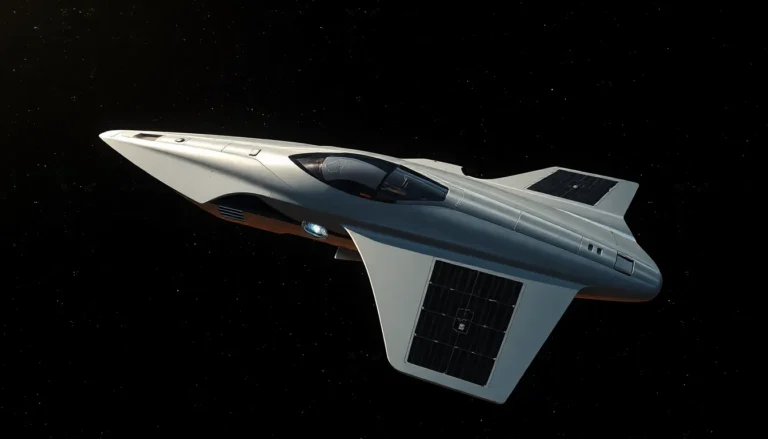Table of Contents
ToggleIn the fast-paced world of military technology, hypersonic glide vehicles (HGVs) are the new kids on the block, and they’re making quite the entrance. Imagine a sleek missile that can zip through the atmosphere at speeds over five times the speed of sound—now that’s a game changer! While traditional missiles are still stuck in traffic, HGVs are soaring above, leaving adversaries scratching their heads and wondering how to keep up.
But it’s not just about speed; it’s about stealth, maneuverability, and the ability to outsmart defenses like a ninja at a surprise party. As nations race to develop these cutting-edge weapons, the stakes are higher than ever. So buckle up as we dive into the fascinating world of hypersonic glide vehicles, where the future of warfare is being reshaped at breakneck speed.
Overview of Hypersonic Glide Vehicles
Hypersonic glide vehicles (HGVs) represent cutting-edge technology in the realm of defense systems. Capable of flying at speeds greater than Mach 5, these vehicles combine speed with aerodynamic capabilities. They achieve this rapid movement through a unique gliding phase after being launched from a rocket.
Maneuverability sets HGVs apart from traditional missiles. Unlike ballistic trajectories, HGVs can adjust their flight path mid-air, which complicates tracking and interception for existing missile defense systems. Countries are actively developing these systems to gain a strategic edge in military capabilities.
Stealth technology contributes significantly to their effectiveness. Many HGVs utilize advanced materials and designs that reduce radar signatures, making them harder to detect. This combination of speed, maneuverability, and stealth leads to challenges in defense strategies.
Various nations are investing in HGV research and development. The United States, Russia, and China are among the leaders in this field, each conducting tests to refine their own technologies. Recent tests demonstrate successful flight missions and further validate the potential of HGVs.
Hypersonic glide vehicles are redefining modern warfare. Their unique characteristics require nations to reconsider existing defense strategies as they prepare for evolving threats in the military landscape. Real-time capabilities and advanced features ensure that HGVs will play a crucial role in future military engagement.
Key Features of Hypersonic Glide Vehicles
Hypersonic glide vehicles (HGVs) boast several distinctive features that enhance their operational effectiveness and strategic value. These features include speed and maneuverability as well as advanced design and technology.
Speed and Maneuverability
Speed characterizes HGVs, allowing them to travel at over five times the speed of sound. This velocity significantly reduces flight time to targets. Maneuverability complements speed, enabling HGVs to change paths mid-flight, which complicates interception efforts. The ability to adapt flight trajectories results in a challenging scenario for traditional missile defense systems. Furthermore, this agile movement enhances the likelihood of success in strike missions, making them a formidable asset in modern warfare.
Design and Technology
Design plays a crucial role in HGV functionality. These vehicles utilize a unique gliding phase after launch, which differentiates them from traditional ballistic weapons. Innovative materials ensure structural integrity at extreme speeds, while stealth technology minimizes radar signatures. Advanced guidance systems offer precision targeting capabilities, allowing HGVs to strike designated areas accurately. Nations invest heavily in research and development to improve these technologies, continually refining their designs to enhance performance and effectiveness.
Advantages of Hypersonic Glide Vehicles
Hypersonic glide vehicles (HGVs) present numerous advantages in military and potential commercial realms. Their unique capabilities significantly enhance operational effectiveness.
Strategic Military Applications
HGVs offer enhanced strike capabilities due to their speed and maneuverability. They can reach targets within minutes, making response times drastically shorter than traditional weapon systems. Additionally, the ability to maneuver mid-flight complicates defense mechanisms for adversaries, increasing the likelihood of successful engagements. Nations can integrate HGVs into existing military frameworks, allowing for diverse applications such as rapid response, deterrence, and precision strikes. Their stealth features also reduce detection risk, providing tactical advantages on the battlefield. Consequently, HGVs represent a critical evolution in military strategy, prompting nations to reassess defense postures.
Potential for Commercial Use
In commercial sectors, HGV technology holds promise for ultra-fast delivery systems. The reduced transit times could transform logistics and cargo transport, allowing goods to travel across vast distances in a fraction of the time. Companies could utilize such technology to deliver essential products rapidly, benefiting e-commerce and global supply chains. By minimizing delays, HGVs enhance customer satisfaction and operational efficiency. Innovative applications may include rapid medical supplies delivery during emergencies or expedited transport of crucial components in manufacturing. As HGV technology matures, the commercial landscape may witness significant shifts driven by speed and efficiency improvements.
Challenges and Limitations
Hypersonic glide vehicles (HGVs) face several significant challenges that hinder their operational effectiveness.
Technical Hurdles
Designing HGVs comes with various technical challenges. Achieving sustained hypersonic speeds requires advanced materials that can withstand extreme heat and pressure. Additionally, maintaining aerodynamic stability during flight poses difficulties for engineers. Guidance systems need to be highly sophisticated to allow for accurate target acquisition and mid-air maneuverability. Testing these vehicles also demands extensive experimentation to ensure they perform reliably under different conditions. Ultimately, these technical hurdles must be overcome before HGVs can reach their full potential in military operations.
Regulatory and Ethical Considerations
Developing HGV technology raises important regulatory and ethical questions. Nations must navigate international treaties governing missile technology and arms control. Balancing military advancements with global security interests creates complex challenges for policymakers. Heightened concerns regarding arms races emerge as nations prioritize HGV research and development. Ethical implications also arise regarding the potential for misuse and increased civilian risk. Addressing these regulatory and ethical considerations is crucial for the responsible deployment of HGVs in future conflicts.
Conclusion
Hypersonic glide vehicles represent a transformative leap in military technology with their unparalleled speed and agility. As nations explore their potential, the implications for global defense strategies are profound. The ability to strike quickly and accurately necessitates a reevaluation of current defense systems, pushing countries to innovate or risk obsolescence.
Moreover, the commercial applications of HGV technology could reshape logistics and supply chains, offering unprecedented delivery speeds. However, the journey forward isn’t without challenges. Addressing the technical hurdles and ethical considerations surrounding HGVs will be crucial in ensuring their responsible use. As this technology continues to evolve, the balance between advancement and regulation will define its future impact on both military and civilian sectors.







